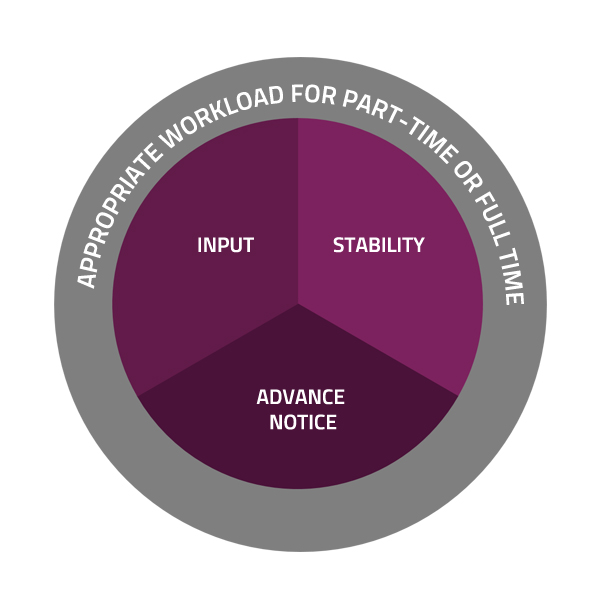

Global professional services firm EY has been working with Timewise for a number of years, to champion and showcase the value of flexible working to UK business. We asked them to share their insights into why it’s important and what the impact has been, so that other businesses can benefit.

By Cathy Halstead, Editor, Timewise
Here at Timewise, we are keen to share our flexible working expertise as widely as possible. But as we all know, the peer to peer viewpoint is also a highly useful resource. So we asked Justine Campbell, EY’s Managing Partner for Talent, UK and Ireland – responsible for attracting and retaining talent – to share what the firm has learned, and how it has benefitted, from the journey to a fully flexible culture. Here are her insights.
As our recent Power 50 awards highlighted, flexible working is no longer about people juggling caring responsibilities. People of all ages, from all sorts of backgrounds, are choosing to work flexibly for a wide range of reasons. The result, Justine believes, is that flexible working is no longer a nice to have; it’s becoming an expectation from prospective employees.
“In a 24/7 global culture, backed up by supportive technology, flexibility is becoming the norm. So any employer that wants to be truly competitive needs to have flexible working as standard. It’s a business imperative.”
It seems obvious, then, that making flexible working available to potential candidates should be part of a future-focused firm’s recruitment strategy. But being willing isn’t enough, says Justine.
“If you want to attract the best talent, you need to be prepared to shout about your approach to flexible working, not wait to be asked. And given the number of hires we make each year – over 2,000 experienced candidates in 2018 – this is something we take seriously.
“We state clearly that our roles are open to flexibility, and empower and challenge our hiring teams and line managers to deliver on this. For us, the key question is not ‘Can we make it work’ but ‘How can we make it work?’”
Similarly, flexible working has a big impact on retention; by offering people what they want, you’re more likely to keep hold of them for longer. And it doesn’t end there, according to Justine.
“We often say that you can’t put a price on flexible working. Speaking personally, I wouldn’t trade my flexibility for a salary hike; it’s worth too much to me. But at a firm-wide level, being able to hang on to talented employees is about more than just retention rates.
“For example, Michael Heap, who was a 2019 Timewise Power Climber, now works for us three days a week, to free up time to develop his own tech business (Tmup). This is teaching him new skills and developing his entrepreneurial abilities. EY and our clients will benefit from that as much as we do from his day-to-day experience.
Proactively offering flexible working to potential and current employees is also likely to lead to a more diverse workforce. And that has been shown to have a positive impact on the business as a whole, as Justine notes.
“It’s easy for businesses that don’t have diversity of experience to get stuck in their ways. In our world, we need a degree of professional scepticism, which we wouldn’t get if we only had identikit employees. Successful workplaces reflect the outside world, whether that’s in terms of gender, age or ethnicity, and flexible working has a key role to play in making that happen.
Clearly, formally defined arrangements such as part-time or annualised contracts need formal contracts. But Justine has found that incorporating informal flexibility into EY’s culture is also part of the solution.
“We think of it in terms of outputs – that is, what needs to be delivered by when – rather than focusing on how long people are sitting at their desks. So if one of my team wants to go for a run before starting work, or drive home before making a call to avoid the rush hour, that’s fine by me.
“As long as you trust your employees (and if you don’t, perhaps you should question why you employ them), you should be happy for them to work in the way that suits them best. In my experience, it makes people more productive, as well as having a positive effect on their wellbeing and loyalty.”
However, to make all these elements work together, there’s one factor that can’t be overlooked: the role played by an organisation’s leadership. As Justine explains:
“There are so many factors involved in making flexible working a success, from investing in technology and job design to championing role models and training line managers. It’s not just an add-on or a written policy; you have to embed flexible working into your company culture. And that’s not going to happen unless it comes from the top.
“We have members of our leadership team working part-time or flexing their hours in a variety of ways, and they’re very open about it. That kind of visibility is worth a huge amount; our leaders are not only setting our flexible strategy, they’re also showing by example that it can be done.”
As EY’s experience shows, a lot of work goes into creating a successful flexible working strategy. And, as Justine and the team at EY have found, it’s well worth getting expert support.
“We’ve been collaborating with Timewise on our flexible hiring strategy since we started on this journey and their support has been invaluable. They have set the standard for flexible working and will ensure you make a success of it.
“The fact is, if you want to be competitive in the future, you need to be flexible. The future of work starts now; get some support, make a start and make it happen.”
Now that flexible working has become more mainstream, we’re more likely to be found advising clients about how to make it happen than why they should do so. But it doesn’t hurt to have a reminder of how being flexible can benefit your business.
From finding and keeping the best people to cutting overheads, here are the reasons why forward-looking businesses are making flexible working a priority.

If you want to get your hands on the very best people in your industry, you need to take flexible working seriously. 87% of full-time workers either work flexibly already, or wish they could. The numbers are similar for men (84%) and women (91%). And amongst people who are not currently working, 93% want a job that includes some sort of flexibility.
But according to the 2023 Flexible Jobs Index, just 3 in 10 jobs are advertised with flexible working options. This huge gap between supply and demand means that offering flexibility gives you a bigger pool of candidates to choose from. It will also give you the edge over your less flexible rivals.
Once you’ve got the best people in, and spent time and money training them, it makes sense to try and keep them. And whereas financial incentives only tend to buy short term loyalty, real flexibility is harder to come by – and so more likely to encourage people to stay.
A survey by the CIPD1 backs this theory up, with 75% of employers saying that flexible working has a positive effect on retention and 73% saying it improves staff motivation. So, if you want to hang on to your star employees, offering them flexibility is a great place to start.
True flexibility isn’t a one-off negotiating tool. If you build it into every level of your organisation, you won’t just encourage your staff to stay; you’ll allow them to progress too.
By making flexible working available within senior and board roles, you’ll provide your flexible employees with a clear career pathway. This will allow your organisation to make the most of their skills and experience, rather than leaving them stuck in roles that don’t make the best of their abilities.
You’re also likely to increase the proportion of women at a senior level, which is known to bring a wider perspective into decision making, and to help close the gender pay gap.
The role that flexible working plays in improving female representation at senior level is also important from an inclusion perspective.
According to a report by McKinsey, gender-diverse companies are 15% more likely to achieve financial returns above their industry average. Given that most companies now have a formal inclusion and diversity policy, flexibility is a useful tool in improving your gender balance.
Flexible working can also support the inclusion of older workers, by allowing them to work for longer and ease into retirement. And it can help people with disabilities or mental health issues stay in work, by making it easier to balance their job with the need to take care of their well-being and attend medical appointments.
It’s often assumed that flexible workers are less engaged and less productive than their full-time peers. In fact, the opposite is true.
A survey by BT in 2014 found that the productivity of flexible workers increased by 30%. And in a study of flexible workers undertaken by Cranfield University2, 97% of managers said the quantity of work improved or stayed the same and 93% said the quality of the work improved or stayed the same.
Finally, although it’s an obvious point, it’s worth repeating: by allowing your employees to work remotely, you’re likely to have less people in the building at once.
This can allow you to reduce both your office space and your carbon footprint, and cut your business overheads significantly. For example, BT have stated that reducing their physical office space through flexibility has yielded global savings of £100 million a year.
But you don’t have to take our word for all this. Businesses agree, too: the 2015 CBI Employment Trends Report states that almost all businesses (94%) believe flexibility is vital or important to the competitiveness of the UK’s labour market and for prospects for investment and job creation. If you’re convinced of the why, and ready to start exploring the how, we’re here to help.
Updated January 2022
1 “Flexible Working Provision and Uptake”, CIPD
2 Cranfield University/Working Families 2008: “Flexible Working and Performance”

There’s no doubt that flexible working is becoming an established part of the HR strategy for forward-looking companies. Employers are becoming increasingly vocal about how it benefits their business, and 9 in 10 employees say they want it. What’s more, it has been shown to help tackle a wide range of issues, from talent attraction and retention to the gender pay gap.
But the term ‘flexible working’ is a broad one, which means different things to different people. To add to the confusion, some people and companies use different phrases to describe it, such as ‘agile working’ or ‘smart working’. So here’s our quick guide to what flexible working actually is, how to make it work, and what it could do for you.
At Timewise, we use the term ‘flexible working’ to describe any kind of working pattern that doesn’t fit into the traditional 9-5, five day week. We also believe that flexible roles should be quality, permanent ones which benefit employers and employees alike. So we don’t include zero hours or temping contracts.


Karen Mattison MBE, Co-Founder Timewise
It feels as if the Timewise Power 50 has finally come of age. Launched seven years ago to bring senior part-timers out of the shadows, it has evolved over time to become a high profile celebration of the art of the possible.
What’s changed, and how has it happened? Well, in the intervening years, the debate about flexible working has undergone a big shift. Critically, there’s an increasing acceptance that it benefits companies as much as it does their employees; the business case is no longer in doubt. So instead of talking about WHY we need it, the conversation has moved on to HOW to make it work.
The most varied group of winners to date
As this year’s winners show, there are many different ways to do so. They are the most varied group that we have ever seen, coming from a wide range of organisations of all shapes and sizes. Where else would you see a security chief sharing the limelight with a pair of West-End performers? Or a consultant anaesthetist being celebrated alongside the head of a music label?
And their motivations are equally varied. Some of our winners work flexibly to care for relatives; others do so to write books and musicals. Or to pursue a side-hustle, to dedicate time to not-for-profit projects, or to look after their mental and physical health. The career choices they’ve made are supporting them to live and work in the way they want to, and helping to bust some myths around flexible working on the way.

Over the years, as we’ve been working to bring about more, better flexible working, we have created a core set of principles on which successful flexible job design should be based. As a top line – though of course, it’s a far more in-depth process – this involves looking at where, when and how much people want or need to work, and using this as a base to create roles which suit both employers and employees.
But when it comes to shift-based environments, such as retail, healthcare, warehousing or hospitality, these variables can’t be applied in the same way. The where is often a fixed location – a hospital, for example, or a restaurant. The how much is often problematic because of the low wages associated with many of these roles; for some, a part-time minimum wage isn’t enough to get by. And the when can be too driven by the employer’s requirements – such as needing a full, balanced team to cover each shift – to take employee needs into account.
Does that mean it’s impossible to deliver a good work-life balance for shift-based employees? No. But it does mean we need a different set of principles, and a different way of talking about flexible working, from which to build the change process. So here it is.
Drawing on the work of USA-based academic Sue Lambert, as well as our work in tough-to-crack sectors, we have identified the principles which improve work-life balance for shift workers in the UK. And we’ve used them as a basis for a Shift-Life Balance model for the home market.

Shift-Life Balance: a model for change
The first, overarching principle is about the size and volume of work: does the individual want to work full-time or part-time? Once this has been defined, employers then need to consider:
The aim of these principles is to help employees manage their responsibilities outside of work, make plans and organise the rest of their lives.
Of course, as with all types of flexible job design, identifying the principles that make up this Shift-Life Balance model is just the beginning. The extent to which an employer is willing or able to tackle one or more of them will vary case by case.
And it’s not just a case of making a few tweaks. These principles are fundamental to the way that rosters and shift patterns are created. So any changes need to be tried and tested to ensure that they deliver. That’s where we come in.
We are already using this model in a range of pilots which we’re carrying out through our Innovation Unit, from nursing and retail to teaching, and we’ll share the outcomes as they develop. If you’d be interested in hearing more about what we’re doing, or supporting one of our projects, do please get in touch.
In shift-based environments, the structures and cultures we need to tackle are deeply-embedded, and in some cases, resistant to change. That’s why this work hasn’t been done already – and why it needs the level of expertise that our Innovation Unit can bring.
But if we don’t tackle these challenging sectors, and flexible working remains a white-collar, office-based privilege, what will the impact be? Put simply, we’ll be failing the millions of employees, often in lower paid jobs, who are struggling to balance their work and home lives. And these jobs matter – not just to the people who work in them, but to all of us.
For example, there are an estimated 40,000 nursing vacancies in the UK; the lack of flexible working options has been identified as one of the reasons. Similarly, the construction industry needs 157,000 new recruits by 2021 to keep up with demand. And more than 47,000 new secondary school teachers are needed over the next six years. In total, 5.5 million workers in the UK work shifts – that’s a sixth of the working population.
Workers in these sectors need predictability and control over when they work – just as much as those in office-based jobs. And employers need to find a way to make this happen if they are to motivate and engage their existing employees and, crucially, attract new ones. We believe we can crack these challenging sectors, and that’s why we’re rolling up our sleeves and getting on with this complex work. It’s a prize worth aiming for, for all of us.
Published February 2019

There’s a lot of work going on in the Greater Manchester area around delivering quality jobs that fit with people’s lives. The region’s ten local councils are working with the mayor, Andy Burnham, to shape a plan for good jobs and growth that leaves no one behind. And one of the councils, Manchester City, has taken things a step further by signing up to the Timewise Accreditation Programme. As Sam McVaigh, the council’s Head of Workforce Strategy explains:
“Emma Stewart came to speak at a Council Scrutiny meeting just over a year ago. When she talked about the programme, we were struck by how well it would integrate with much of the work we’re already doing. We felt sure that our drive for equality at work, our employee health and wellbeing strategy and even our carbon reduction agenda would all be enhanced by a stronger focus on flexible working. Most importantly, it also resonated with the kind of place our staff were telling us they wanted to work.
“We were also aware that, as champions of the plan for good jobs within our region, we needed to be the change we wanted to see from local employers. And it was clear that Timewise had the knowledge and experience to help us come up with robust, practical, flexible solutions. So we signed up to the programme, and have been working with Timewise ever since.”
The programme saw Timewise deliver a series of workshops and training programmes, including a bespoke session with over 60 senior managers and the authority’s chief executive. It threw up a number of challenges, which Sam sees as an important part of the learning experience:
“To start with, there was a perception among some managers that flexible working is all about giving employees what they want. So there was a real lightbulb moment when they got their heads around the Timewise concept of two-way flexibility – that is, solutions which benefit employers as much as employees. That was a real turning point in how well managers engaged with the programme.
“We also came across a mindset that flexible working can only really work for office-based staff. Some managers started off by saying “Flexibility just isn’t for us”. But through the work with Timewise, it became clear that there’s much more to it than standard part-time hours or remote working. So, for example, although call centres do need to be staffed between fixed times, options such as compressed hours or nine day fortnights are worth exploring for these teams.”
 By Emma Stewart MBE, Co-Founder
By Emma Stewart MBE, Co-Founder
We hear a lot about the challenges created by an ageing population. With statistics suggesting that one in three of today’s babies will live to 100, the implications for policy areas such as healthcare, housing and the state pension can’t be ignored. The government has highlighted the ageing society as one of the DBEIS’s Four Grand Challenges, and the Centre for Ageing Better has set out the need to make big changes to support older people in their Transforming Later Lives strategy.
Yet the challenge also offers an opportunity, and one which we at Timewise are keen to grasp. Put simply, if people are living longer, they are likely to want or need to work for longer. Indeed, according to the Centre for Ageing Better, there are around a million people aged between 50 and 64 who are involuntarily out of work.
And with 48% of UK employers saying they’re concerned about candidate shortages, there’s a mutually beneficial solution staring us all in the face: more, better, flexible jobs that answer the needs of older workers. So we’re working with the Centre for Ageing Better on an Innovation Unit project to deliver exactly that.
There are many reasons why older people want to keep working. They could be financial, such as the need to boost their income for a potentially long retirement, or to continue supporting younger or older members of the family. They could also be social and emotional; the cliff-edge nature of retirement, and how this affects wellbeing and increases loneliness, is well-known.
So, by staying in work longer, older people are less likely to fall into poverty and suffer from social isolation, both of which impact on their health as well as their quality of life. And, of course, they will also continue to contribute to the economy.
But that doesn’t mean older workers want to continue to work at the same pace or for the same amount of the week. Indeed, one in four UK workers feel they could not do their current job over the age of 60. There are also significant age biases in recruitment and within the workplace, as demonstrated in research by the Policy Exchange.
And, unsurprisingly, older workers frequently have health conditions and caring responsibilities, which can cause them to exit the workforce earlier than they might choose to. According to the DWP, 44% of people aged between 50 and retirement have at least one long-term health condition, and one in five women in their 50s are carers. That doesn’t mean they can’t work; but they might need to work a bit less, or in a different way.
I believe that developing flexible solutions, and working to change employer attitudes, will allow these obstacles to be overcome, and help create a more sustainable path into retirement that is good for them, for society and for the economy. And older employees agree. In a recent government survey, workers over 50 were pretty clear about what they need to stay longer in the workplace:

It’s increasingly understood that employers who take proper care of their employees don’t just get a warm feeling inside. The impact of positive well-being and engagement, on the individual and their performance, is no longer in any doubt. And flexible working has a huge part to play in making this happen.
To start with, it has been shown to support general mental and physical well-being, in a number of ways:
And here are some more specific examples of the positive impact it can have on employees:
For parents of small children, and people looking after an elderly relative, being able to flex around medical appointments, school runs and other logistical issues makes being a carer easier to manage.
When senior level flexible roles are made available, people who need to work flexibly are able to progress their careers, making best use of their skills and improving their job satisfaction.
In a Cranfield University[1] survey of flexible workers, 97% of managers said their quantity of work improved or stayed the same and 93% said their quality of the work improved or stayed the same. Achieving more within a flexible framework is likely to lead to increased job satisfaction.
All of the above make it more likely that flexible workers will be more motivated and happier. According to Dr Mark Winwood, a clinical director of psychological services, “The more control any of us feel we have over our working lives, the better we feel about work.”
It’s for all of these reasons that the demand for flexibility is at an all-time high. Our own research has indicated that 87% of employees either work flexibly already, or wish they could. And according to a survey by the Centre for the Modern Family, 23% of UK workers would be willing to take a pay cut in order to have more flexible working hours.
So if you want to recruit and retain healthy, motivated and productive employees, focusing on flexibility is a great way to start.
Published December 2018
 By Emma Stewart MBE, Co-Founder
By Emma Stewart MBE, Co-Founder
By now, we should all be familiar with the gender pay gap; and here at Timewise we are pretty clear about the role that flexible working can play in closing it. But new figures from the ONS have highlighted another work-related discrepancy between men and women: the length of their commutes.
As the figures show, women are more likely than men to commute for 15 minutes or less, and men are more likely than women to commute for more than an hour. In stark terms, the longer the commute, the more likely it is that it will be made by men. And according to the IFS, this ‘gender commuting gap’ really kicks in in the decade after women have their first child.
Does it matter? Shouldn’t women with a shorter commute just be grateful that they don’t have to sit through traffic or squeeze onto a packed train? Well, no. Whilst no one relishes a long journey to work, the implications of these numbers aren’t good for women – and nor are they good for employers.
The fact that the gender commuting gap widens significantly after childbirth suggests that when women become mothers, they feel they need to work closer to home. This isn’t surprising; after all, given the costs and typical opening hours of childcare, not to mention the emotional side of parenthood, every minute counts.
But as a result, these women are likely to be choosing from a smaller pool of jobs, and so may have to settle for one that doesn’t match their skills or offer proper career progression. We know, for example, that proximity to home is the number one reason for working in retail; we also know that part-time progression within this sector is not widely available (though that’s something we are working to change).
 By Karen Mattison, Co-Founder, Timewise
By Karen Mattison, Co-Founder, Timewise
The publication of the 10 worst excuses for not appointing women to FTSE company boards, taken from the government-backed Hampton-Alexander Review, made me more amused than annoyed. While clearly it’s not great that people believe things like “All the good women have already been snapped up” or “We have one woman already on the board… it’s someone else’s turn”, I’d rather have views like these out in the open, and up for debate, rather than hidden under the surface.
But these people are increasingly out of touch, and their beliefs far less common. The value of having more senior women in the workplace is now widely accepted; what people struggle with more, is how to achieve it. So rather than spend time challenging out-of-date views, I’d rather focus on the fact that there’s a relatively straightforward solution to this issue: more, better flexible roles.
And as we all love a list, here’s my personal (and less contentious) top 10, setting out how to use flexible working to deliver more senior women:
Be open to exploring flexible and hybrid working. Lead from the top; show that you value people’s lives outside work by leaving loudly whether that’s exiting the office or logging off with a clear out-of-office. And train line managers in how to discuss flexible working with their teams. Instead of asking ‘Why?”, start asking “Why not?”
Don’t wait to be asked. Make it clear to your staff that flexible working is an option for everyone, whatever their personal circumstances. Share stories of people who are working flexibly for a variety of reasons, so others understand that they can, too.
There are many extremely talented, ambitious women out there who need a degree of flexibility in order to thrive in and outside work. By offering flex up front, you’ll widen the pool you have to choose from – and attract some brilliant candidates.
Making a job work on a part-time basis doesn’t mean giving people Fridays off and expecting the same outputs. Instead, think about where, when and how much someone needs to work to deliver a role, then design the flexibility to suit.
Post Covid, we’re all more on board with the benefits of being able to work from home, or leave early and log on later; for employees with other responsibilities or health issues, it can dramatically affect their ability to thrive, and progress. Support this by taking action to avoid proximity bias when designing remote or hybrid roles.
Part-time isn’t the only way to work flexibly, and it’s worth considering whether other patterns could work for your organisation. Options such as compressed hours, annualised contracts or job shares might be a better fit for senior women or those on the way up.
If people can see a flexible route upwards, and get support from others who have been there and done that, they’re more likely to stay. Ask your more senior flexible workers to mentor to those coming up behind them, and create a forum for conversations to happen.
Typically, client, teambuilding or networking events take place after work, which can make it harder for parents or carers to attend. By offering a range of options, alternating days and times, and considering virtual alternatives, you’ll get a more inclusive attendee list.
Supporting women back into the workplace is a sure-fire way to get talented, experienced staff and demonstrate your commitment to female progression. Take a look at these guidelines for setting up a returner programme which we co-created for the Government Equalities Office.
Hopefully no one in your organisation holds the views that were given to the Hampton-Alexander Review. But left unchecked, people do have a tendency to recruit others who look and sound like themselves – and right now, that’s likely to deliver more board-level men.
To find out more about how flexible working can deliver improved female progression, contact us via info@timewise.co.uk
Published October 2019